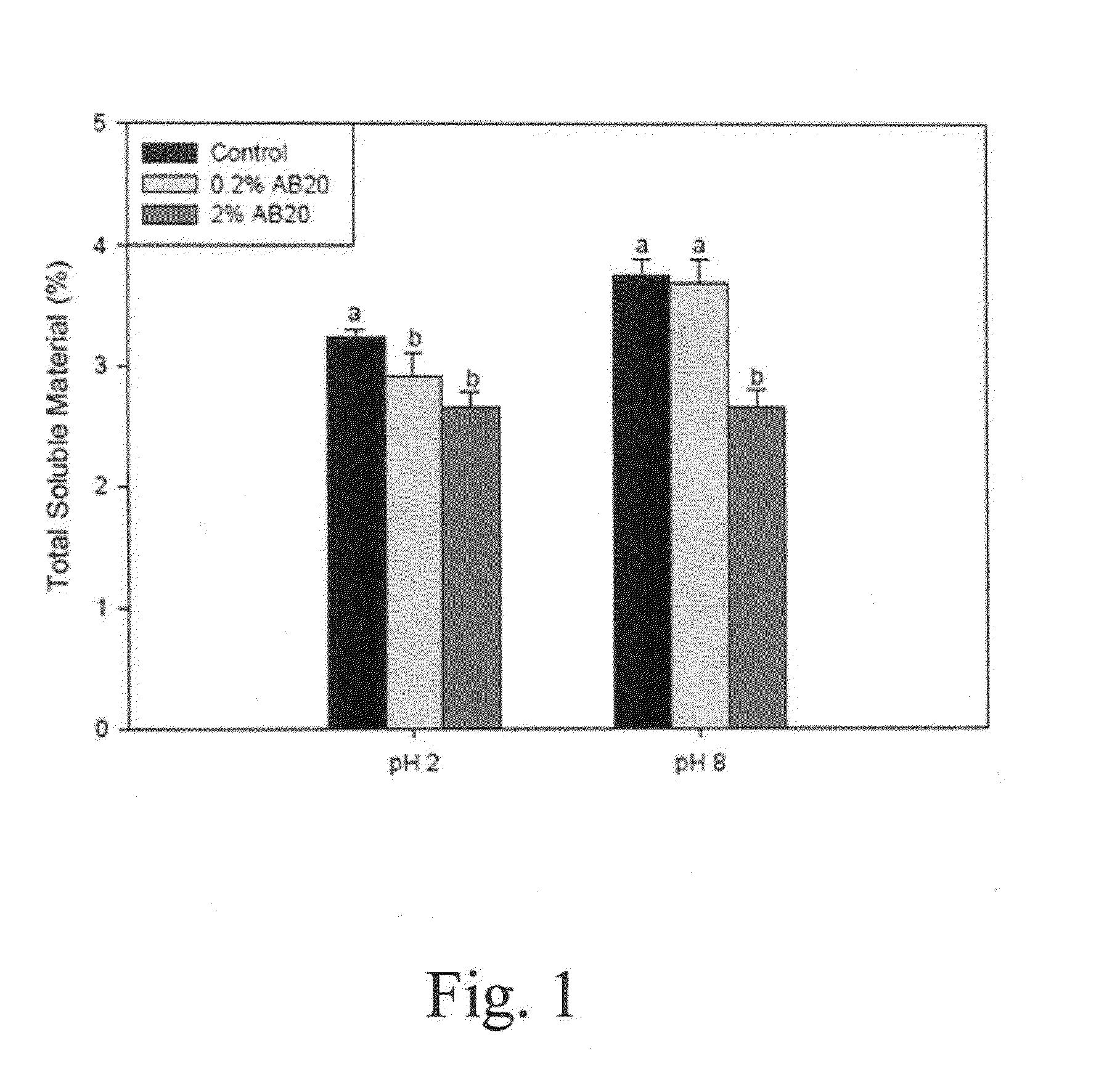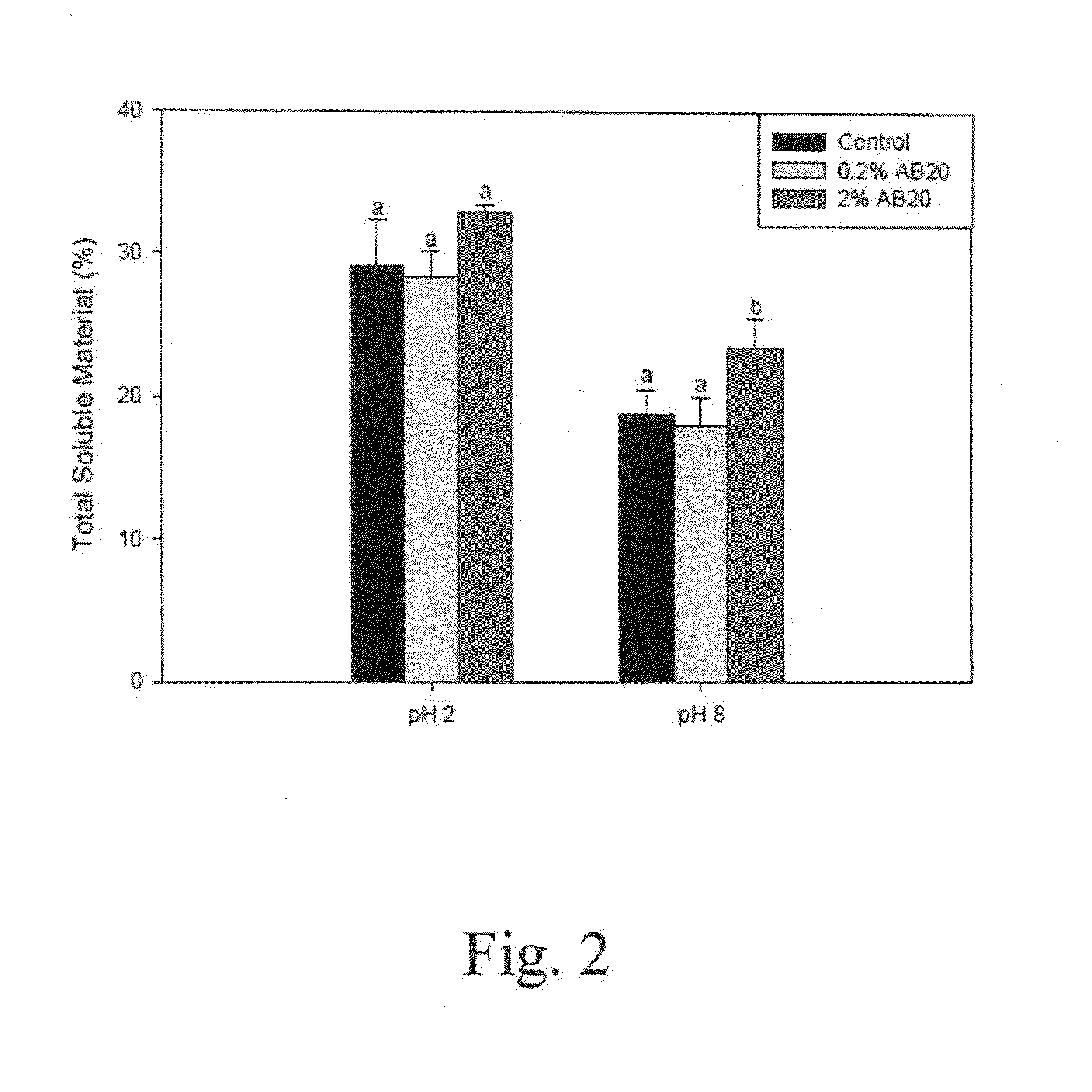Utilization of non-nutritive adsorbents to sequester mycotoxins during extraction of protein or other value added components from mycotoxin contaminated cereal or seed oil meal
a technology of non-nutritive adsorbents and mycotoxins, which is applied in the field of non-nutritive adsorbents to sequester mycotoxins during the extraction of protein or other value added components from mycotoxin contaminated cereal or seed oil meal, which can solve the problems of remarkable toxicity and hepatocarcinogenicity of mycotoxins, the development of cancerous tumors capable of spreading throughout the entire body, and the toxic effect of horses and s
- Summary
- Abstract
- Description
- Claims
- Application Information
AI Technical Summary
Benefits of technology
Problems solved by technology
Method used
Image
Examples
example 1
[0038]Samples were prepared and treated to remove aflatoxin for preparation of a food grade peanut meal derivative as follows: Defatted peanut meal, containing approximately 110 ppb aflatoxin, was provided by Golden Peanut Company (Alpharetta, GA), Astra-Ben 20A™ sodium bentonite clay was provided by Prince Agri Products, Inc (Quincy, Ill.). Methanol, potassium bromide, hydrochloric acid (HCl), acetic acid, and sodium hydroxide (NaOH) were obtained from Fisher Scientific (Fair Lawn, N.J.). Sodium chloride (NaCl) was purchased from Sigma-Aldrich Chemical Company (St. Louis, Mo.). Nitric acid was obtained from VWR International (West Chester, Pa.). AflaTest Developer, AflaTest columns, and mycotoxin standards were acquired from VICAM (Watertown, Mass.). Aflatoxin Mix Kit-M was purchased from Supelco (Bellefone, Pa.).
[0039]Dispersions of defatted peanut meal of approximately 10% w / w, were prepared in deionized water and adjusted to either approximately pH 2.0 or approximately pH 8.0 us...
example 2
[0050]Defatted peanut meal was provided by Golden Peanut Company (Alpharetta, Ga.). The peanut meal was found to be 48.9% protein, as determined by the Dumas combustion method using an Elementar Rapid N III Nitrogen-Analyzer (Elementar Americas, Inc., Mt. Laurel, N.J.). Samples were oven dried overnight at 80° C. Samples (0.2000 ±0.0200g) were prepared in tin foil packets for combustion analysis. Protein was calculated from N values using a Kjeldahl factor of 6.25. Pepsin (EC 232-629-3, Porcine stomach mucosa, 1020 units / mg protein), Alcalase from Bacillus licheniformis 2.4 AU / g (Batch 056K1213, EC 232-752-2), Flavourzyme from Aspergillus oryzae 500 LAPU / g (Batch 084K0543, EC 232-752-2) and trinitrobenzenesulfonic acid (TNBS) were purchased from Sigma-Aldrich Chemical Co. (St. Louis, Mo.). L-Leucine and Trolox (6-hydroxy-2,5,7,8-tetramethylchroman-2-carboxylic acid) were obtained from Fluka BioChemika (Buchs, Switzerland). Fluorescein sodium salt was obtained from Riedel-de Haën (Se...
PUM
 Login to View More
Login to View More Abstract
Description
Claims
Application Information
 Login to View More
Login to View More - R&D
- Intellectual Property
- Life Sciences
- Materials
- Tech Scout
- Unparalleled Data Quality
- Higher Quality Content
- 60% Fewer Hallucinations
Browse by: Latest US Patents, China's latest patents, Technical Efficacy Thesaurus, Application Domain, Technology Topic, Popular Technical Reports.
© 2025 PatSnap. All rights reserved.Legal|Privacy policy|Modern Slavery Act Transparency Statement|Sitemap|About US| Contact US: help@patsnap.com



